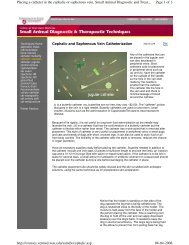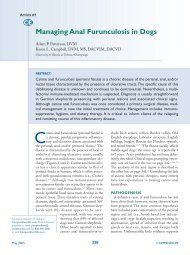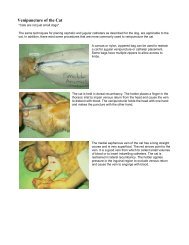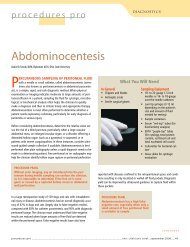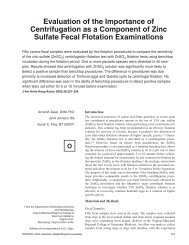Page 3Page 83814Symposium on a three-minuteperipheral <strong>blood</strong> film evaluationThree-minute peripheral <strong>blood</strong> film evaluation: Preparing the filmFred L. Metzger Jr. and Alan RebarNo single hematology procedure produces more valuable information yet requires so littletime and expense than a peripheral <strong>blood</strong> film. Proper preparation and staining of the filmare critical.Three-minute peripheral <strong>blood</strong> film evaluation: The erythron and thrombonFred L. Metzger Jr. and Alan RebarWhen examining the red <strong>blood</strong> cells and platelets in a <strong>blood</strong> film, ask yourself thesequestions to quickly identify and further characterize conditions such as anemia andthrombocytopenia.Three-minute peripheral <strong>blood</strong> film evaluation: The leukonFred L. Metzger Jr. and Alan RebarTaking a moment to briefly examine white <strong>blood</strong> cells will help you identify conditions suchas inflammation or stress that may indicate serious disease.PEER-REVIEWEDSymposium on a three-minuteperipheral <strong>blood</strong> film evaluationMYRIAM KIRKMAN-OH, KO STUDIOSMany veterinarians and technicians do not routinely evaluate <strong>blood</strong> <strong>films</strong> microscopically,largely because they lack confidence in either preparing a well-made <strong>blood</strong>film or in being able to accurately identify important abnormalities. But <strong>blood</strong> <strong>films</strong>should be evaluated whenever a complete <strong>blood</strong> count (CBC) is requested, regardless ofwhether the CBC is done in the clinic or at a reference laboratory. Blood film evaluation is asessential to a CBC as a microscopic examination of urine sediment is to a complete urinalysisor two views are to proper radiographic interpretation. No single hematology procedure producesmore valuable information yet requires so little additional time (we recommend threeminutes) and expense.Even the most expensive hematology analyzers are not designed to eliminate peripheral<strong>blood</strong> film evaluation. Morphologic features that instruments cannot identify include left shifts(increased immature neutrophils), neutrophil toxicity, lymphocyte reactivity, white <strong>blood</strong> cell(WBC) malignancy, red <strong>blood</strong> cell (RBC) poikilocytosis, RBC inclusions, and platelet abnormalities.A quick <strong>blood</strong> film review will help validate certain numerical data including plateletcounts, WBC counts, WBC differentials, and RBC density, since even reference laboratory analyzersprove inaccurate with some of the more abnormal samples.In this symposium, we suggest using a systematic method for <strong>evaluating</strong> <strong>blood</strong> <strong>films</strong>. Thismethod—which requires veterinarians and technicians to answer basic questions about RBC,WBC, and platelet numbers and morphology—maximizes hematologic information. And wecover the most common and important morphologic findings in the peripheral <strong>blood</strong>.We hope this symposium will provide veterinary practitioners and technicians with theskills to properly prepare, stain, and evaluate a peripheral <strong>blood</strong> film and will encouragethem to use this vital hematology tool in their practices.—Dr. Fred L. Metzger Jr.All articles have been reviewed by at least two board-certified specialists or recognized experts to ensure accuracy, thoroughness, and suitability.2
PEER-REVIEWEDThree-minute peripheral <strong>blood</strong> film evaluation:Preparing the filmNo single hematology procedure produces more valuable information yet requires so little time and expense than aperipheral <strong>blood</strong> film evaluation. Proper preparation and staining of the film are critical.Fred L. Metzger Jr., DVM, DABVP(canine and feline practice)Metzger Animal Hospital1044 Benner PikeState College, PA 16801Alan Rebar, DVM, PhD, DACVPDepartment of Veterinary PathobiologySchool of Veterinary MedicinePurdue UniversityWest Lafayette, IN 47907A PERIPHERAL BLOOD FILM evaluation should bepart of all complete <strong>blood</strong> counts (CBCs), regardlessof whether hematology is performedin-house or at a reference laboratory. Propersample collection, slide preparation, andstaining are essential to accurately evaluate a<strong>blood</strong> film, as is the correct use of a highqualitymicroscope. This article describes thesteps in preparing a <strong>blood</strong> film and theequipment you’ll need.Components of and indications for a CBCImportant components of a CBC include <strong>evaluating</strong>the erythron (hematocrit, total red <strong>blood</strong>cell [RBC] count, hemoglobin concentration,absolute reticulocyte count, and RBC indices),the leukon (total white <strong>blood</strong> cell [WBC] count,five-part differential count including immatureneutrophils), the thrombon (platelet countand platelet indices), and the total proteinconcentration. As mentioned earlier, alwaysinclude a peripheral <strong>blood</strong> film evaluation inthe CBC.A CBC should be included in evaluations ofevery sick patient, every patient with vaguesigns of disease, and every patient receivinglong-term medications. In addition, a CBCshould be performed as part of every preanestheticworkup, for adult wellness and geriatricprofiles, and as a recheck test for patients inwhich RBC, WBC, or platelet abnormalities werepreviously diagnosed.Collecting a sample for the <strong>blood</strong> filmArtifacts must be avoided for proper hematologicinterpretation. Causes of artifacts includepoor <strong>blood</strong> collection techniques, inadequatesample volumes, prolonged sample storage,and delayed sample analysis.Proper <strong>blood</strong> collection is vital to prevent erroneousresults from sample clotting and cellularlysis. Obtain hematology samples from thelargest <strong>blood</strong> vessel possible to minimize cellulartrauma and to prevent the activation of clottingmechanisms. For accurate results, discardclotted samples and collect fresh samples. Commonvenipuncture sites in dogs and cats includethe jugular, cephalic, and lateral and medialsaphenous veins. Anticoagulants includeEDTA, heparin, and citrate. EDTA is the preferredanticoagulant for <strong>blood</strong> film preparation becauseit preserves cellular detail better thanother anticoagulants do and does not interferewith Romanowsky staining of WBCs.Inadequate sample volume is a commoncause of inaccurate hematologic results. Properlyfill anticoagulated <strong>blood</strong> collection tubes toavoid falsely decreased hematocrits and cellcounts and to prevent RBC shrinkage.Hematologic samples must be analyzed assoon as possible to prevent artifacts created byexposure to anticoagulants and cell deteriorationdue to storage and shipment. Analyze sampleswithin three hours or refrigerate them at39.2 F (4 C) to avoid an artificially increasedhematocrit, increased mean corpuscular volume,and decreased mean corpuscular hemoglobinconcentration. 1 Prepare <strong>blood</strong> <strong>films</strong>within one hour of collection to avoid morphologicartifacts. RBC crenation, neutrophil hypersegmentation,lymphocytic nuclear distortion,and general WBC degeneration including vacuolizationin neutrophils may occur in agedsamples. In addition, monocyte vacuolization,monocyte cytoplasmic pseudopod formation,and platelet agglutination can be encounteredin stored samples. 2 If you use a reference laboratoryfor primary hematologic analyses, werecommend submitting freshly prepared <strong>blood</strong><strong>films</strong> along with the anticoagulated <strong>blood</strong>.3





